Two children lie on a sofa, one reading, the other staring into space, only vaguely aware of his mother at her easel. Drawers are pulled out, a cat sits on a ledge before what might be a window, or a canvas propped behind the sofa. Pot plants still in their cellophane and left hastily on the floor attest to the unruly rush of home life. It looks like a frank portrait of gentle domestic chaos, but the painting’s monumental scale is indicative of its complexity and heft. Hung at the beginning of this exhibition at Piano Nobile’s Kings Place gallery, Sofas Galore (c. 1980s) provides a key to Jean Cooke’s work, to the various paces and pitches at which she looks, and paints, and thinks about painting.
The boys are not two, but one: both are her son Jason, caught on different occasions sitting on a sofa that, as Cooke told Andrew Lambirth in 2007, ‘dominated my life’. It suggests both the snatched nature of these encounters – that she had to take the chance to paint when it came – and the pragmatism that informed her realism, and her commitment to a single subject, however it might present itself. If it suggests an artist who, despite being elected an RA in 1972 was barely able to find time to paint, this is because Sofas Galore tells us of the facts of Cooke’s daily life as much as it reveals her artistic imagination. She was married to John Bratby, whose unremittingly joyless pictures of daily life are synonymous with the kitchen-sink style of the late 1950s. He was a bullying, violent man, who did his best to stifle Cooke’s career, and this exhibition, a decade or so on from Piano Nobile’s 2007 retrospective, is an important step in reconsidering an artist whose reputation has been almost entirely eclipsed by that of her husband.
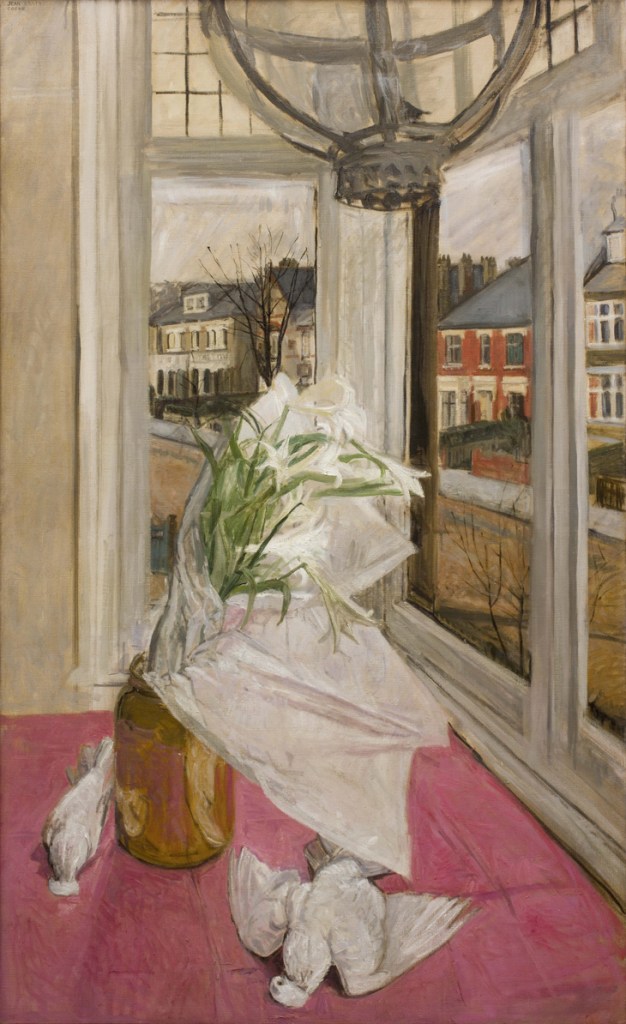
Up the Road and Pigeon Die (1964), Jean Cooke. © The artist’s estate, courtesy Piano Nobile
This sofa, then, which we imagine was in the middle of the house, is a refuge of sorts, a makeshift studio, even. The plants hint at Cooke’s artistic ancestry; still wrapped, they evoke not just the forgetful chaos of home life but Winifred Nicholson’s pot plants – Cyclamen and Primula (c. 1923), for example – painted some 60 years earlier.
Nicholson’s wrappers animate and monumentalise the modest plants they contain, but in Cooke’s Up the Road and Pigeon Die (1964), the cellophane around a bunch of lilies has a deadening effect. The pigeons take on the limp and lifeless qualities of the cellophane; the cellophane takes on the rigidity and weight of the dead birds. In its preoccupation with tactile, structural properties, the painting nods to Cooke’s early career as a sculptor. Its elongated portrait format and a powerful diagonal thrust direct the gaze towards the surrounding bay window, making us long to get into the picture, to see this still life from other angles, sculpture-like.
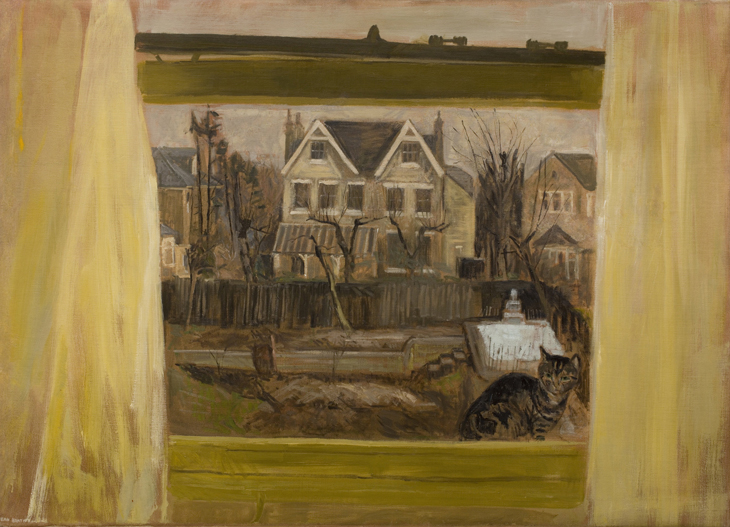
Out the Back and Pussy Cat (1964), Jean Cooke. © The artist’s estate, courtesy Piano Nobile
Though offering a painstakingly detailed view, the window is firmly closed against a remote and unreachable world, and this claustrophobia is ramped up still further in Out the Back and Pussy Cat (1964). If a view generally implies freedom, Cooke’s views from her home in Blackheath present a series of barriers, beginning with the curtains, then the oppressive horizontals of the window frame, then the garden fence, then the houses beyond. The cat sat outside looking in is a symbol not of cosy domesticity, but of freedom beyond reach. Its incongruously bright, sing-song title makes this painting all the more disconcerting: Out the Back and Pussy Cat is a line that lends itself to mantra-like repetition, as if to to steady a psyche wobbling off balance.
Here, like it or not, biography must come in. Women artists are especially prey to psychological interpretations, and it would be grossly simplistic to suggest that Cooke’s work is primarily a response to her personal circumstances. But Cooke said she was terrified of her husband: ‘I used to tell lies so I didn’t get beaten up,’ she told Andrew Lambirth. On other occasions Bratby would lock her up, and at various points he destroyed her paintings.
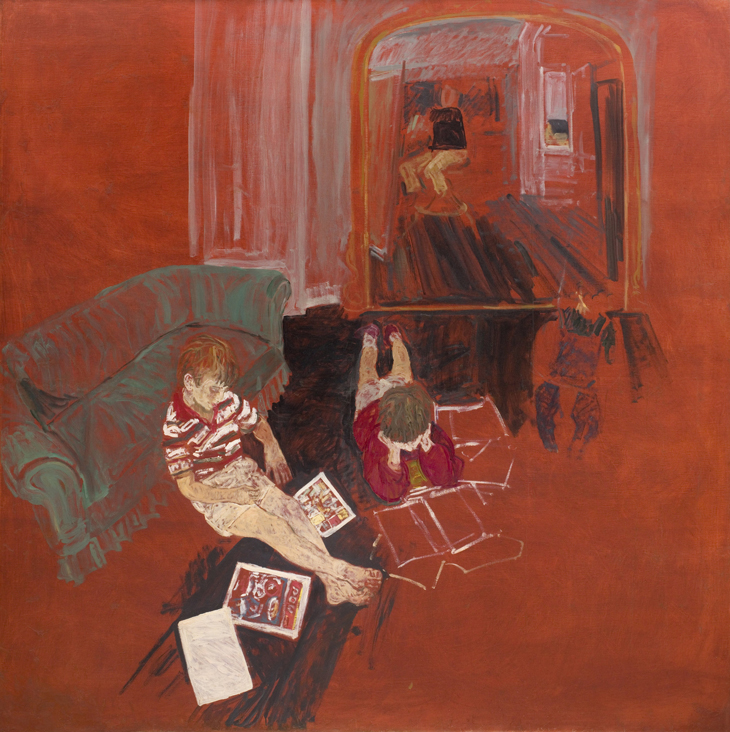
Two Boys Reading (n.d.), Jean Cooke. © The artist’s estate, courtesy Piano Nobile
If it is in an artist’s nature to look at things differently, one feels in Cooke’s case that she looks intently, at angles, and under and around things, in order to find a pocket of freedom for herself, a process that is paralleled to some extent by the experience of close looking that her works demand. In her painting Two Boys Reading, undated, her own self-portrait might easily be missed as it hides in plain sight, there but not there, reflected in a mirror at the top of the picture.
Joyous liberation is felt in Cooke’s pictures of the outdoors, which have a painterly vigour absent from the domestic scenes. A view down from a cliff edge is at once abstract and representational, and grouped together, these closely observed paintings of texture and pattern have the quality of museum specimens, or objects in a cabinet of curiosities.
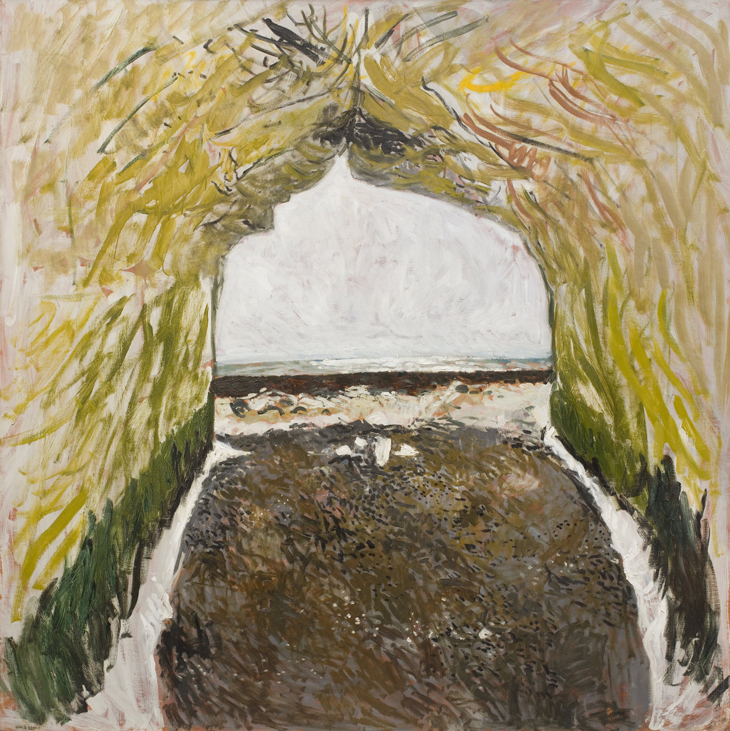
Cave Painting I (n.d.), Jean Cooke. © The artist’s estate, courtesy Piano Nobile
Most significantly, this exhibition includes paintings made at the family’s holiday home at Birling Gap, East Sussex. Here Cooke made a series of what she called cave paintings, these views out to the sea offering an irresistible contrast to her views from windows. In Cave Painting I, undated, the sense of being enclosed is quite overwhelming, and yet there is nothing oppressive about it: instead the sea, and the sexually compelling imagery of a dark, cool cave, give it a primal sort of freedom that attests not only to the removal of physical constraints, but to the solace that comes from a retreat deep into one’s own psyche.
‘Jean Cooke: A Modern Venus’ is at Piano Nobile, Kings Place, until 27 April.
Unlimited access from just $16 every 3 months
Subscribe to get unlimited and exclusive access to the top art stories, interviews and exhibition reviews.

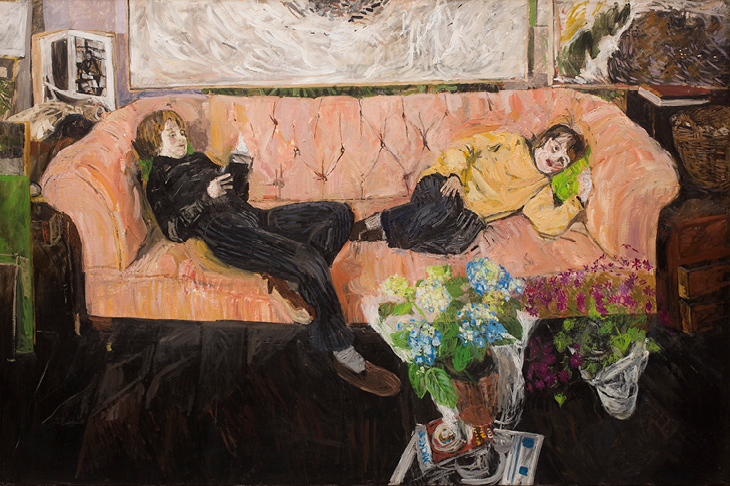
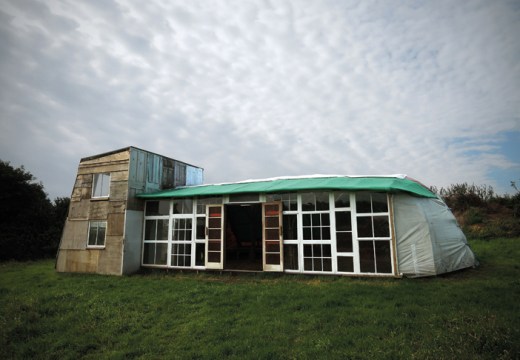
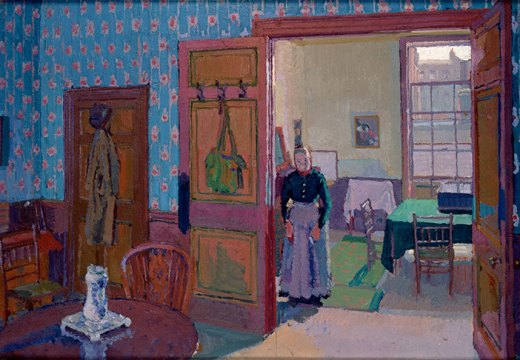
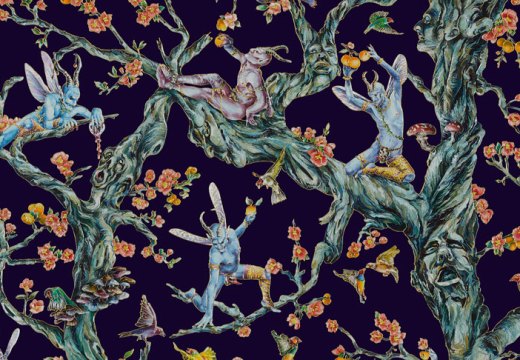









![Masterpiece [Re]discovery 2022. Photo: Ben Fisher Photography, courtesy of Masterpiece London](http://www.apollo-magazine.com/wp-content/uploads/2022/07/MPL2022_4263.jpg)
It’s time for the government of London to return to its rightful home